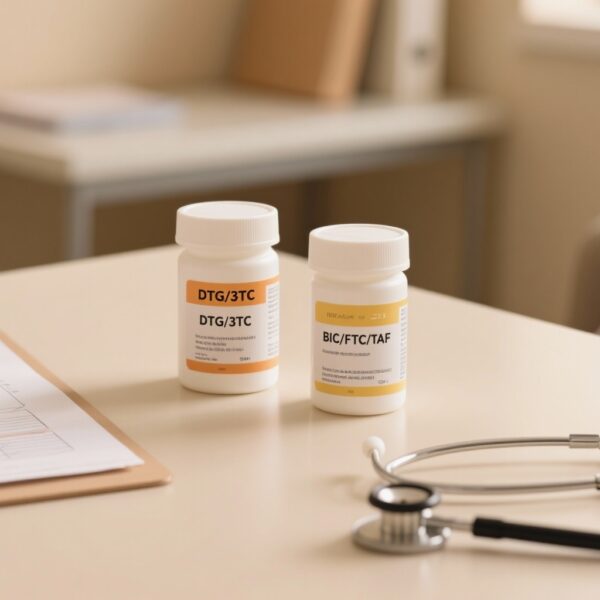Highlights
- Early-phase clinical trials demonstrate good safety and tolerability profiles of novel broadly neutralising antibodies (bNAbs) N6LS, PGDM1400LS, and PGT121.414.LS in healthy adults.
- All bNAbs show extended serum half-lives (approximately 49 to 71 days), supporting less frequent dosing schedules for prophylaxis or therapy.
- Subcutaneous administration is feasible with acceptable bioavailability, enhanced by formulations such as ENHANZE drug product (EDP) for N6LS.
- Neutralisation activity is preserved in vivo, supporting their potential use in combination strategies to prevent or treat HIV-1 infection.
Background
Broadly neutralising monoclonal antibodies (bNAbs) against HIV-1 are a promising approach to both prevention and treatment of HIV infection. They offer the ability to neutralise diverse viral strains by targeting conserved epitopes on the viral envelope glycoprotein. However, clinical effectiveness relies on improvements in neutralisation breadth, potency, and pharmacokinetic profiles such as extended serum half-lives. Early-phase clinical trials are critical to determine safety, tolerability, pharmacokinetics, and functional neutralisation capacity in humans, informing further development and combination strategies. The antibodies N6LS, PGDM1400LS, and PGT121.414.LS represent recent advances with engineered variants designed to improve half-life and bioavailability.
Key Content
Overview of Evaluated Antibodies and Study Designs
Three recent first-in-human phase 1 clinical trials assessed the safety, pharmacokinetics, and neutralisation activity of distinct HIV-1 bNAbs in healthy adults aged 18–50 years without HIV infection in the USA. These open-label, dose-escalation studies administered antibodies either intravenously or subcutaneously at various doses to characterize dose response, tolerability, and pharmacodynamics.
| Antibody | Target Epitope | Modification | Dose Range | Route | Sample Size | Study Registry |
|---|---|---|---|---|---|---|
| N6LS | CD4 binding site | LS mutation for half-life extension | 5–40 mg/kg | IV and SC with/without EDP | 33 | NCT03538626 |
| PGDM1400LS | V2 apex on HIV envelope | Lysine-serine modification for half-life increase | 5–40 mg/kg | IV and SC | 15 | NCT05184452 |
| PGT121.414.LS | V3 glycan supersite | LS mutation for prolonged half-life | 3–30 mg/kg alone; plus VRC07-523LS combination | IV and SC | 33 | NCT04212091 |
Safety and Tolerability
Across all three trials, the bNAbs demonstrated acceptable safety profiles in healthy adult volunteers with no serious adverse events or dose-limiting toxicities reported. Injection site reactions following subcutaneous administration were generally mild to moderate, with pain or tenderness being the most common symptoms for N6LS and PGDM1400LS. N6LS administered with ENHANZE drug product (recombinant human hyaluronidase PH20) caused mild to severe erythema at injection sites, which resolved without intervention and did not significantly affect participants.
Systemic reactogenicity was mild and transient in all groups. Anti-drug antibody responses that could neutralize or clear the administered bNAbs were not detected in the evaluated time windows.
Pharmacokinetics and Bioavailability
All three bNAbs showed extended half-lives compared to their parental forms, owing to LS or lysine-serine modifications enhancing FcRn-mediated recycling:
- N6LS: Mean serum half-life ~48.6 days; subcutaneous bioavailability improved with ENHANZE drug product administration, enabling higher dose SC delivery.
- PGDM1400LS: Median elimination half-life ~55 days, a 2- to 3-fold increase relative to parental PDGM1400; estimated subcutaneous bioavailability 50–60%.
- PGT121.414.LS: Estimated half-life 71 days (three times parental PGT121); subcutaneous bioavailability ~86% (95% CI 64.0–95.5).
Dose proportionality was observed in serum antibody concentrations for both intravenous and subcutaneous administrations across the dose ranges studied. Timing of peak concentrations differed with route, peaking immediately after IV infusion and approximately 6 days post-subcutaneous dose, consistent with absorption kinetics.
Neutralisation Activity In Vivo
Serum samples from participants retained broad and potent neutralisation activity against multiple HIV-1 strains, as measured by the TZM-bl assay, correlating well with measured serum concentrations:
- N6LS: Maintained potent broad neutralising activity in serum post-administration.
- PGDM1400LS: Serum neutralisation titres (ID80) consistent with predicted titres based on serum concentrations, confirming functional retention.
- PGT121.414.LS: Neutralisation activity greater at higher doses and enhanced when combined with VRC07-523LS compared to single or subcutaneous administration, indicating synergistic potential.
These findings suggest that the antibodies remain functionally active in vivo and capable of targeting HIV-1 effectively at therapeutic concentrations.
Expert Commentary
The early clinical evaluations of N6LS, PGDM1400LS, and PGT121.414.LS demonstrate their potential as safe and durable agents in the armamentarium against HIV-1. The engineered LS and lysine-serine Fc domain modifications extend pharmacokinetic half-lives significantly, addressing a key barrier—frequent administration—facing monoclonal antibody-based prophylaxis and treatment.
Subcutaneous delivery, especially when combined with hyaluronidase (EDP), provides a patient-friendly and scalable approach for repeated administrations. Encouragingly, neutralisation potency is retained across administration routes and dosing regimens, supporting their further evaluation in combination immunoprophylactic regimens.
The combination of PGT121.414.LS with VRC07-523LS exemplifies the rationale of using multiple bNAbs targeting distinct envelope epitopes to mitigate viral escape, improve breadth, and augment neutralisation. These initial phase 1 data align with prior preclinical and early-phase trials of older bNAbs but bring improved pharmacokinetics that may translate to enhanced clinical utility.
Challenges remain regarding optimal dosing intervals, long-term immunogenicity, integration with antiretroviral therapy, and efficacy in diverse populations, including those with established infection. Future randomized controlled efficacy trials are warranted to define clinical benefit explicitly.
Conclusion
Recent first-in-human phase 1 trials evaluating the broadly neutralising monoclonal antibodies N6LS, PGDM1400LS, and PGT121.414.LS demonstrate favorable safety, tolerability, and extended serum half-life profiles in healthy adults without HIV. Subcutaneous delivery with enhanced formulations is feasible and well tolerated. Importantly, neutralisation potency persists in vivo, supporting their role in combination strategies for HIV prevention and treatment. These advances foundationally support progressive clinical development, including larger efficacy trials, aiming to expand bNAb-based interventions and advance HIV-1 control efforts globally.
References
- Ying B et al. Safety and pharmacokinetics of N6LS, a broadly neutralising monoclonal antibody for HIV: a phase 1, open-label, dose-escalation study in healthy adults. Lancet HIV. 2025 Jul;12(7):e485-e495. doi: 10.1016/S2352-3018(25)00041-4. PMID: 40409326
- Gaudinski MR et al. Safety, pharmacokinetics, and neutralisation activity of PGDM1400LS, a V2 specific HIV-1 broadly neutralising antibody, infused intravenously or subcutaneously in people without HIV-1 in the USA (HVTN 140/HPTN 101 part A): a first-in-human, phase 1 randomised trial. Lancet HIV. 2025 Jun;12(6):e405-e415. doi: 10.1016/S2352-3018(25)00012-8. PMID: 40441807
- Mendoza P et al. Safety, tolerability, pharmacokinetics, and neutralisation activities of the anti-HIV-1 monoclonal antibody PGT121.414.LS administered alone and in combination with VRC07-523LS in adults without HIV in the USA (HVTN 136/HPTN 092): a first-in-human, open-label, randomised controlled phase 1 trial. Lancet HIV. 2025 Jan;12(1):e13-e25. doi: 10.1016/S2352-3018(24)00247-9. PMID: 39667379



